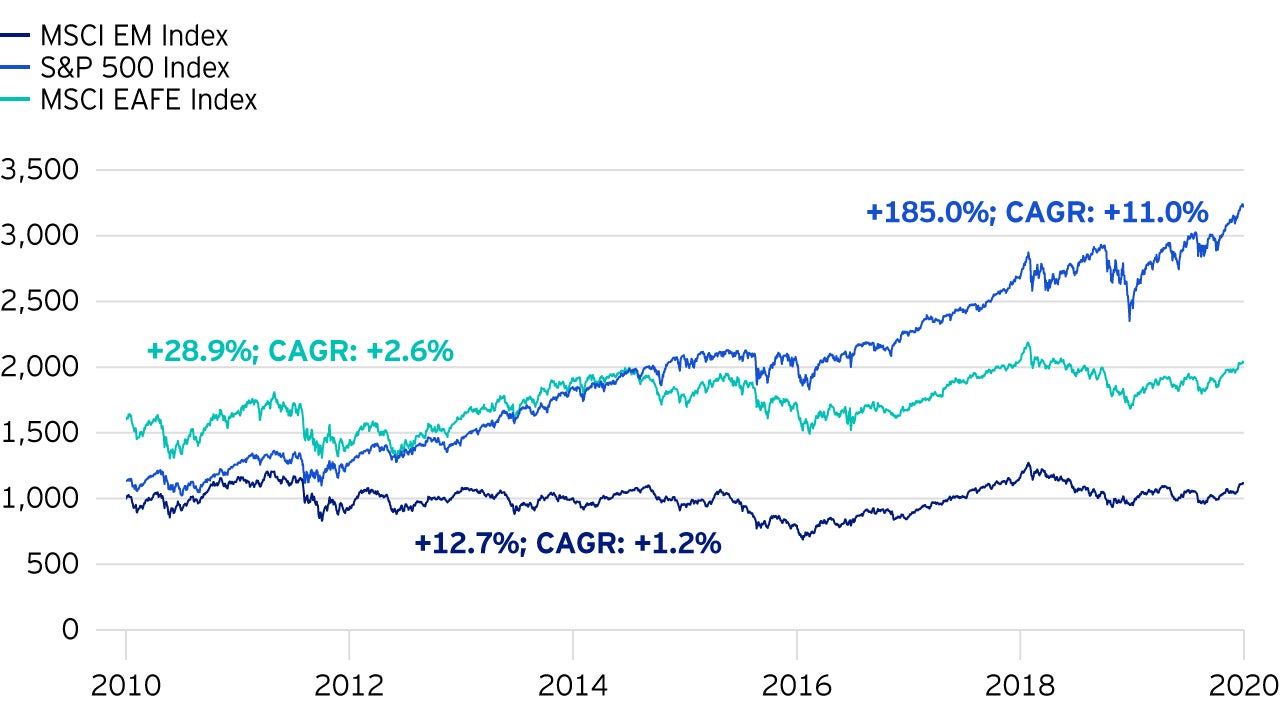Two key factors drove that poor performance.
- The economic growth rates in EM overall didn’t recover after the global financial crisis of 2008-2009.
- The collapse in commodities prices of 2014-2015.
Key themes of the past decade
The poor fortunes of EM during the past decade also put to rest many of the assumptions investors had made about EM.
- The BRICS couldn’t continue a strong path of economic growth and development.
The notion that all the BRICS countries - Brazil, Russia, India, China and South Africa - were on the same development track proved to be overly optimistic.
Growth in Russia, Brazil and South Africa came to a halt, as the economies were adversely affected by weak commodity prices.
India continued to be in a deep economic slump.
All four of these countries were also plagued by some combination of weak domestic savings, high levels of inequality with low social mobility, insufficient fiscal capacity to spur their economies, and low degrees of economic openness, the latter of which negatively impacts the ease of exports and imports.
China’s growth rate, which had been as high at 9.5% in 2011, slowed through the decade and hovered in the 6% range by the end of the decade.1
- Even with all its promise, China’s economy couldn’t maintain a pace of near double-digit growth.
The slowdown in China seemed to catch some by surprise.
While China is still among the world’s fastest-growing economies, it couldn’t sustain the torrid pace it had set previously.
Some of the contributing factors included a saturation in its share of the global export market and the fact that its real estate and automobile sectors had reached the peak of their cycles.
While spending from the government helped bolster the country’s flagging growth, those fiscal interventions proved to be unsustainable in the medium term.
Themes we foresee for the year and decade ahead
While some investors may have lost some faith in EM, we foresee several trends that we think will help turn around the fortunes of select EM and reward investors who are careful stock pickers in these regions.
- China’s growth rate will likely stabilise.
We think private investment should recover and there should be greater geopolitical confidence along with cautious policy stimulus.
We expect the shift towards consumption and private investment in the country should be propelled further by greater social spending in areas such as pensions and health care.
- We expect economic growth across EM will slowly recover.
We believe a weaker US dollar and low interest rates globally should allow central banks in emerging countries to be more aggressive with monetary easing.
With a lower cost of capital, private sector investment should also likely recover.
We expect the global manufacturing recession to reverse.
In our view, credit markets in countries outside of China should also recover from their current abnormally low levels.
- We believe EM equities markets could outperform the US stock market over the next decade.
For many of the same reasons stated above - the prospect of a weak US dollar and low global interest rates - we think the EM equity markets, which are already relatively inexpensive, could recover in the years ahead and potentially outperform the US stock market.
- We expect a mean reversion in returns that could bring a market shift toward value
We foresee substantial opportunities for outsized returns in neglected EM value stocks, as shown by the bifurcation of performance between high-quality growth stocks and everything else from a bottom-up perspective.







